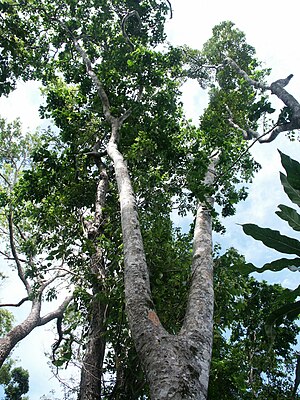Benutzer:Shi Annan/Intsia bijuga
| Borneo-Teak, Merbau | ||||||||||||
|---|---|---|---|---|---|---|---|---|---|---|---|---|

Merbau (Intsia bijuga) | ||||||||||||
| Systematik | ||||||||||||
| ||||||||||||
| Wissenschaftlicher Name | ||||||||||||
| Intsia bijuga | ||||||||||||
| (COLEBR.) KUNTZE |
Merbau oder Borneo-Teak (Intsia bijuga, auch: Johnstone River teak, Kwila, Moluccan ironwood, Pacific teak, scrub mahogany, vesi[1][2][3]) ist eine Pflanzenart aus der Unterfamilie der Johannisbrotgewächse (Caesalpinioideae) innerhalb der Familie der Hülsenfrüchtler (Fabaceae). Diese Art kommt in der Indopazifik-Region vor. Ihre Verbreitung erstreckt sich von Tansania und Madagaskar nach Osten durch Indien und Queensland (Australien), Papua-Neuguinea bis zu den Pazifikinseln Fidschi und Samoa.[1][2][4] Er erreicht Höhen bis zu 50 m mit stark ausgebildeten Brettwurzeln, die hoch hinauf am Stamm gehen. mangrove forests. Intsia bijuga differ from Intsia palembanica in the number of leaflets that make up their compound leaves.[5]
The tree has a variety of common names including ipil and kwila.[6]
Nutzung[Bearbeiten | Quelltext bearbeiten]
The bark and leaves of the ipil are used in traditional medicines. The tree's timber, called kwila (taal in the Philippines, merbau in Australia, vengai in Tamil Nadu and South India), is a very durable and termite-resistant wood, making it a highly valued material for flooring and other uses. The wood can also be used to extract a dye. The tree can contain a "gold" fleck that runs through the grain, considered to be attractive by some. Due to extensive logging of the tree, it is endangered in many places in Southeast Asia, and almost extinct in some.[7] Extensive amounts were purchased for the venue of the 2008 Summer Olympics in China, which is the largest importer of the wood.[8] The wood is used for flooring in U.S. and European markets where it is commonly sold under different names. Both licensed and unlicensed mills harvest the wood.
Illegale Holzernte[Bearbeiten | Quelltext bearbeiten]
According to Greenpeace large amounts of ipil timber sourced from illegal logging is being imported into China where there are lax import rules. Greenpeace are targeting users in Western countries in order to halt the trade in ipil wood. Greenpeace claims that at the current rate of logging the tree will be wiped out within 35 years.[8]
In Neuseeland, where the ipil wood is known as kwila, attempts have been made to stop it from being imported. In 2008 retailers were divided in whether the sale of kwila should be banned. Jim Anderton, who was the Minister in charge of the Ministry of Agriculture and Forestry at that time, did not support a ban and instead he left it up to consumer choice.[9]
Symbolgehalt[Bearbeiten | Quelltext bearbeiten]
Intsia bijuga, locally known as ifit, is the official tree of the United States territory of Guam. No longer abundant since World War II, it is illegal on Guam to cut live ifit trees. It remains the most popular wood for local carvers.[10]
Einzelnachweise[Bearbeiten | Quelltext bearbeiten]
- ↑ a b F.A. Zich, B.P.M Hyland, T. Whiffen, R.A. Kerrigan: Intsia bijuga. In: Australian Tropical Rainforest Plants, Edition 8. Commonwealth Scientific and Industrial Research Organisation (CSIRO), 2020, abgerufen am 7. April 2021 (englisch).
- ↑ a b Shi Annan/Intsia bijuga im Germplasm Resources Information Network (GRIN), USDA, ARS, National Genetic Resources Program. National Germplasm Resources Laboratory, Beltsville, Maryland.
- ↑ Intsia bijuga (vesi). In: Agroforestry.org. Abgerufen am 7. April 2021 (englisch).
- ↑ PNGTreesKey - Intsia bijuga Kuntze. In: www.pngplants.org. Abgerufen am 12. Februar 2021 (englisch).
- ↑ Tropical Legumes: Resources for the Future : Report of an Ad Hoc Panel of the Advisory Committee on Technology Innovation, Board on Science and Technology for International Development, Commission on International Relations, National Research Council. National Academies, 1979, NAP:14318, 216 (archive.org): Intsia bijuga and Intsia palembanica differ mainly in the number of leaflets that make up their compound leaves. Both are native to tropical rainforests in Southeast Asia and the islands of the southwest Pacific.
- ↑ Tree Conservation Information Service. UNEP-WCMC, 5. September 2007, archiviert vom am 15. Januar 2007; abgerufen am 23. August 2008.
- ↑ Wild Singapore
- ↑ a b Michael Bristow: China trade threatens tropical trees, BBC, 6. Juli 2007
- ↑ Eloise Gibson: Stores divided over calls to ban kwila. In: New Zealand Herald. 18. August 2008, abgerufen am 26. Juni 2010.
- ↑ Robert W. Wescom: Guam Trees: Ifit. In: Guampedia. 19. März 2021, abgerufen am 6. April 2021.
Literatur[Bearbeiten | Quelltext bearbeiten]
- F.A. Zich, B.P.M Hyland, T. Whiffen, R.A. Kerrigan: Intsia bijuga. In: Australian Tropical Rainforest Plants, Edition 8. Commonwealth Scientific and Industrial Research Organisation (CSIRO), 2020, abgerufen am 5. März 2021.
- Sze Pang Cheung, Tiy Chung, Tamara Stark: Merbau's Last Stand. Greenpeace International, Amsterdam, 17. April 2007.
- Jamartin Sihite: Bintuni Bay Nature Reserve Management Plan - Irian Jaya Barat Province 2006-2030. The Nature Conservancy, 2005, ISBN 978-979-97700-3-5 (coral-triangle.org ( des vom 30. September 2011 im Internet Archive) [abgerufen am 22. März 2007]).
Weblinks[Bearbeiten | Quelltext bearbeiten]
- Commons: Intsia bijuga – Sammlung von Bildern, Videos und Audiodateien
- Wikispecies: Intsia bijuga – Artenverzeichnis
- CIRAD Forestry Department — timber data
Taxonbar|from=Q12700996 {{Normdaten|TYP=s|GND=4334300-4}} [[Kategorie:Johannisbrotgewächse]] [[Kategorie:Baum]] Intsia|bijuga]] [[Category:Trees of Africa]] [[Category:Flora of tropical Asia]] [[Category:Trees of the Pacific]] [[Category:Trees of Madagascar]] [[Category:Trees of Seychelles]] [[Category:Trees of Taiwan]] [[Category:Flora of the Zanzibar Archipelago]] [[Category:Fabales of Australia]] [[Category:Trees of Australia]] [[Category:Flora of Queensland]] [[Category:Vulnerable biota of Queensland]] [[Category:Vulnerable flora of Australia]] [[Category:Vulnerable flora of Asia]] [[Category:Plants described in 1891]]